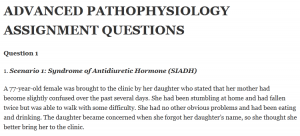ADVANCED PATHOPHYSIOLOGY ASSIGNMENT QUESTIONS
Question 1
1. Scenario 1: Syndrome of Antidiuretic Hormone (SIADH)
A 77-year-old female was brought to the clinic by her daughter who stated that her mother had become slightly confused over the past several days. She had been stumbling at home and had fallen twice but was able to walk with some difficulty. She had no other obvious problems and had been eating and drinking. The daughter became concerned when she forgot her daughter’s name, so she thought she better bring her to the clinic.
HPI: Type II diabetes mellitus (DM) with peripheral neuropathy x 30 years. Emphysema. Situational depression after death of spouse 6-months ago
SHFH: – non contributary except for 40 pack/year history tobacco use.
Meds: Metformin 1000 mg po BID, ASA 81 mg po qam, escitalopram (Lexapro) 5 mg po q am started 2 months ago
Labs-CBC WNL; Chem 7- Glucose-102 mg/dl, BUN 16 mg/dl, Creatinine 1.1 mg/dl, Na+116 mmol/L,
K+4.2 mmol/L, CO237 m mol/L, Cl-97 mmol/L.
The APRN refers the patient to the ED and called endocrinology for a consult for diagnosis and management of syndrome of inappropriate antidiuretic hormone (SIADH).
Question: Define SIADH and identify any patient characteristics that may have contributed to the development of SIADH
ANSWER
Question 2
1. Scenario 2: Type 1 Diabetes
A 14-year-old girl is brought to the pediatrician’s office by his parents who are concerned about their daughter’s weight loss despite eating more, frequent urination, unquenchable thirst, and fatigue that is interfering with her school activities. She had been seemingly healthy until about 4 months ago when her parents started noticing these symptoms. She admits to sleeping more and gets tired very easily.
PMH: noncontributory.
Allergies-NKDA
FH:- maternal uncle with “some kind of sugar diabetes problem” but parents unclear on the exact disease process
SH: denies alcohol, tobacco or illicit drug use. Not sexually active.
Labs: random glucose 244 mg/dl.
DIAGNOSIS: Diabetes Mellitus type 1 and refers to an endocrinologist for further work up and management plan.
Question: Explain the pathophysiology of the three P’s for (polyuria, polydipsia, polyphagia)” with the given diagnosis of Type I DM.
ANSWER
Question 3
1. Scenario 2: Type 1 Diabetes
A 14-year-old girl is brought to the pediatrician’s office by his parents who are concerned about their daughter’s weight loss despite eating more, frequent urination, unquenchable thirst, and fatigue that is interfering with her school activities. She had been seemingly healthy until about 4 months ago when her parents started noticing these symptoms. She admits to sleeping more and gets tired very easily.
PMH: noncontributory.
Allergies-NKDA
FH:- maternal uncle with “some kind of sugar diabetes problem” but parents unclear on the exact disease process
SH: denies alcohol, tobacco or illicit drug use. Not sexually active.
Labs: random glucose 244 mg/dl.
DIAGNOSIS: Diabetes Mellitus type 1 and refers to an endocrinologist for further work up and management plan.
Question: Explain the genetics relationship and how this and the environment can contribute to Type I DM.
ANSWER
Question 4
1. Scenario 3: Type II DM
A 55-year-old male presents with complaints of polyuria, polydipsia, polyphagia, and weight loss. He also noted that his feet on the bottom are feeling “strange” “like ants crawling on them” and noted his vision is blurry sometimes. He has increased an increased appetite, but still losing weight. He also complains of “swelling” and enlargement of his abdomen.
PMH: HTN – well controlled with medications. He has mixed hyperlipidemia, and central abdominal obesity. Physical exam unremarkable except for decreased filament test both feet. Random glucose in office 333 mg/dl.
Diagnosis: Type II DM and prescribes oral medication to control the glucose level and also referred the patient to a dietician for dietary teaching.
Question: How would you describe the pathophysiology of Type II DM?
ANSWER
Question 5
1. Scenario 4: Hypothyroidism
A patient walked into your clinic today with the following complaints: Weight gain (15 pounds), however has a decreased appetite with extreme fatigue, cold intolerance, dry skin, hair loss, and falls asleep watching television. The patient also tearfulness with depression, and with an unknown cause and has noted she is more forgetful. She does have blurry vision.
PMH: Non-contributory.
Vitals: Temp 96.4˚F, pulse 58 and regular, BP 106/92, 12 respirations. Dull facial expression with coarse facial features. Periorbital puffiness noted.
Diagnosis: hypothyroidism.
Question: What causes hypothyroidism?